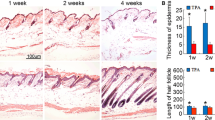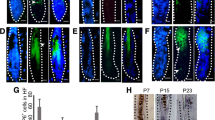Abstract
Programmed cell death protein-1 (PD-1) is primarily recognized as an inhibitory receptor involved in the regulation of immunological tolerance. However, recent studies have indicated that PD-1/PD-L1 signaling could also regulate the functions of nonimmune cells and may be involved in regulating hair biology. In this study, we showed in a mouse model of depilation-induced hair cycling that PD-1/PD-L1 are expressed in the murine epidermis and hair follicle (HF) in a hair cycle-dependent manner. During HF morphogenesis, PD-1 expression was strongly decreased during the anagen phase compared with the catagen and telogen phases. PD-L1 expression was enhanced during the catagen phase compared with the anagen and telogen phases. Moreover, direct blockade of PD-L1 not only accelerated hair anagen phase onset but also delayed catagen progression. In conclusion, our findings indicated that PD-1/PD-L1 signaling may act as a negative regulator of hair cycle transition. Anti-PD-1/PD-L1 therapy may thus be a promising strategy for treating anagen-reduced hair loss.




Similar content being viewed by others
References
Ma X, Tian Y, Song Y, Shi J, Xu J, Xiong K, Li J, Xu W, Zhao Y, Shuai J, Chen L, Plikus MV, Lengner CJ, Ren F, Xue L, Yu Z (2017) Msi2 maintains quiescent state of hair follicle stem cells by directly repressing the Hh signaling pathway. J Invest Dermatol 137:1015–1024
Schneider MR, Schmidt-Ullrich R, Paus R (2009) The hair follicle as a dynamic miniorgan. Curr Biol 19:R132-142
Singh SK, Kumar V, Rai T (2020) Comparison of efficacy of platelet-rich plasma therapy with or without topical 5% minoxidil in male-type baldness: a randomized, double-blind placebo control trial. Indian J Dermatol Venereol Leprol 86:150–157
Pratt CH, King LE Jr, Messenger AG, Christiano AM, Sundberg JP (2017) Alopecia areata. Nat Rev Dis Primers 3:17011
Qin W, Hu L, Zhang X, Jiang S, Li J, Zhang Z, Wang X (2019) The diverse function of PD-1/PD-L pathway beyond cancer. Front Immunol 10:2298
Verma V, Shrimali RK, Ahmad S, Dai W, Wang H, Lu S, Nandre R, Gaur P, Lopez J, Sade-Feldman M, Yizhak K, Bjorgaard SL, Flaherty KT, Wargo JA, Boland GM, Sullivan RJ, Getz G, Hammond SA, Tan M, Qi J, Wong P, Merghoub T, Wolchok J, Hacohen N, Janik JE, Mkrtichyan M, Gupta S, Khleif SN (2019) PD-1 blockade in subprimed CD8 cells induces dysfunctional PD-1(+)CD38(hi) cells and anti-PD-1 resistance. Nat Immunol 20:1231–1243
Seliger B (2019) Basis of PD1/PD-L1 Therapies. J Clin Med 8(12):2168. https://doi.org/10.3390/jcm8122168
Topalian SL, Taube JM, Pardoll DM (2020) Neoadjuvant checkpoint blockade for cancer immunotherapy. Science 367(6477):eaax0182. https://doi.org/10.1126/science.aax0182
Liu Y, Jing H, Kou X, Chen C, Liu D, Jin Y, Lu L, Shi S (2018) PD-1 is required to maintain stem cell properties in human dental pulp stem cells. Cell Death Differ 25:1350–1360
Chen G, Kim YH, Li H, Luo H, Liu DL, Zhang ZJ, Lay M, Chang W, Zhang YQ, Ji RR (2017) PD-L1 inhibits acute and chronic pain by suppressing nociceptive neuron activity via PD-1. Nat Neurosci 20:917–926
Rivera N, Boada A, Bielsa MI, Fernández-Figueras MT, Carcereny E, Moran MT, Ferrándiz C (2017) Hair repigmentation during immunotherapy treatment with an anti-programmed cell death 1 and anti-programmed cell death ligand 1 agent for lung cancer. JAMA Dermatol 153:1162–1165
Zhou L, Wang H, Jing J, Yu L, Wu X, Lu Z (2018a) Regulation of hair follicle development by exosomes derived from dermal papilla cells. Biochem Biophys Res Commun 500:325–332
Zhou L, Wang H, Jing J, Yu L, Wu X, Lu Z (2018b) Morroniside regulates hair growth and cycle transition via activation of the Wnt/β-catenin signaling pathway. Sci Rep 8:13785
Müller-Röver S, Handjiski B, van der Veen C, Eichmüller S, Foitzik K, McKay IA, Stenn KS, Paus R (2001) A comprehensive guide for the accurate classification of murine hair follicles in distinct hair cycle stages. J Invest Dermatol 117:3–15
Kwack MH, Kim MK, Kim JC, Sung YK (2012) Dickkopf 1 promotes regression of hair follicles. J Invest Dermatol 132:1554–1560
Ohn J, Kim KH, Kwon O (2019) Evaluating hair growth promoting effects of candidate substance: a review of research methods. J Dermatol Sci 93:144–149
Ge M, Liu C, Li L, Lan M, Yu Y, Gu L, Su Y, Zhang K, Zhang Y, Wang T, Liu C, Liu F, Li M, Xiong L, Wang K, He T, Dai Y, Zhao Y, Li N, Yu Z, Meng Q (2019) miR-29a/b1 inhibits hair follicle stem cell lineage progression by spatiotemporally suppressing WNT and BMP signaling. Cell Rep 29:2489-2504.e2484
Lee MH, Im S, Shin SH, Kwack MH, Jun SE, Kim MK, Kim JC, Sung YK (2012) Conditioned media obtained from human outer root sheath follicular keratinocyte culture activates signalling pathways that contribute to maintenance of hair-inducing capacity and increases trichogenicity of cultured dermal cells. Exp Dermatol 21:793–795
Premanand A, Reena Rajkumari B (2018) Androgen modulation of Wnt/β-catenin signaling in androgenetic alopecia. Arch Dermatol Res 310:391–399
Yi R (2017) Concise review: mechanisms of quiescent hair follicle stem cell regulation. Stem Cells 35:2323–2330
Houschyar KS, Borrelli MR, Tapking C, Popp D, Puladi B, Ooms M, Chelliah MP, Rein S, Pförringer D, Thor D, Reumuth G, Wallner C, Branski LK, Siemers F, Grieb G, Lehnhardt M, Yazdi AS, Maan ZN, Duscher D (2020) Molecular mechanisms of hair growth and regeneration: current understanding and novel paradigms. Dermatology 236:271–280
Yokosuka T, Takamatsu M, Kobayashi-Imanishi W, Hashimoto-Tane A, Azuma M, Saito T (2012) Programmed cell death 1 forms negative costimulatory microclusters that directly inhibit T cell receptor signaling by recruiting phosphatase SHP2. J Exp Med 209:1201–1217
Akilli Öztürk Ö, Pakula H, Chmielowiec J, Qi J, Stein S, Lan L, Sasaki Y, Rajewsky K, Birchmeier W (2015) Gab1 and Mapk signaling are essential in the hair cycle and hair follicle stem cell quiescence. Cell Rep 13:561–572
Simoneau M, Coulombe G, Vandal G, Vézina A, Rivard N (2011) SHP-1 inhibits β-catenin function by inducing its degradation and interfering with its association with TATA-binding protein. Cell Signal 23:269–279
Acknowledgements
This study was supported by the National Natural Science Foundation of China (Grant Nos. 81673074, 81972959, 81773350 and 81902409).
Author information
Authors and Affiliations
Corresponding authors
Ethics declarations
Conflict of interest
The authors declare no conflicts of interest.
Additional information
Publisher's Note
Springer Nature remains neutral with regard to jurisdictional claims in published maps and institutional affiliations.
Rights and permissions
About this article
Cite this article
Zhou, L., Wen, L., Sheng, Y. et al. The PD-1/PD-L1 pathway in murine hair cycle transition: a potential anagen phase regulator. Arch Dermatol Res 313, 751–758 (2021). https://doi.org/10.1007/s00403-020-02169-9
Received:
Revised:
Accepted:
Published:
Issue Date:
DOI: https://doi.org/10.1007/s00403-020-02169-9




